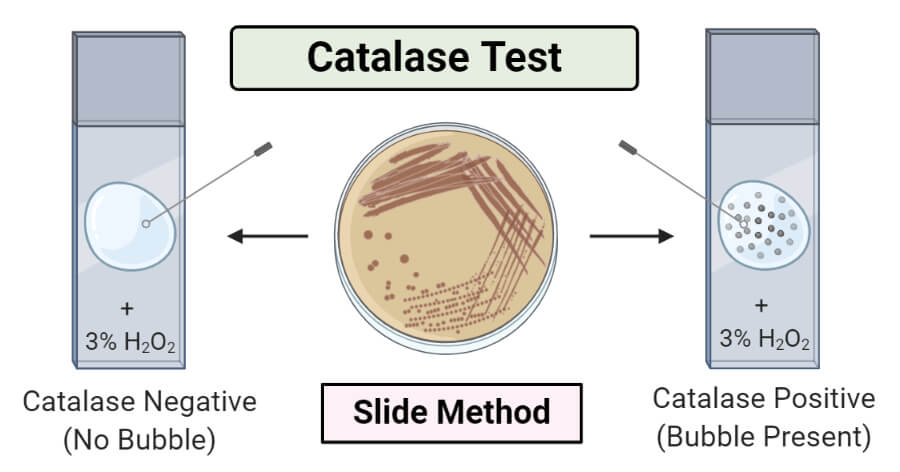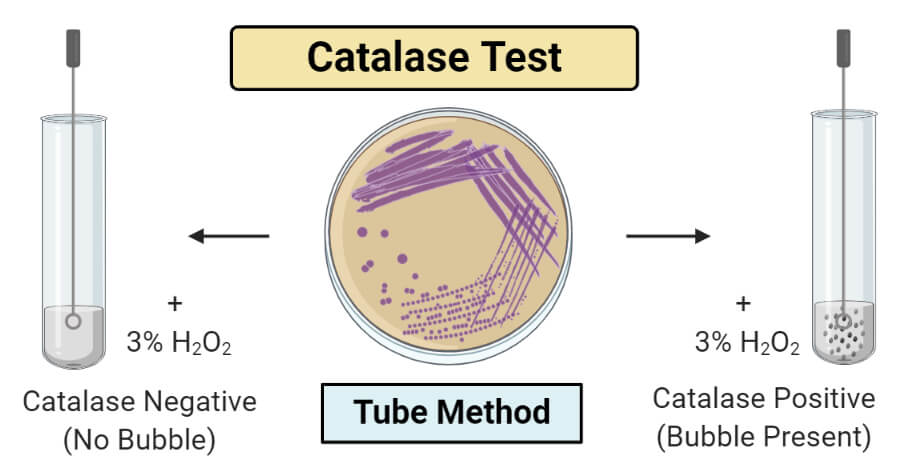The catalase test is a biochemical test for aerobic organisms that detects the production of catalase enzyme in the organism.
- Catalase enzyme is a common enzyme that is found in all living beings that survive in oxygen and catalyzes the decomposition of hydrogen peroxide, releasing water and oxygen.
- Catalase is an essential enzyme in pathogenic organisms as it protects the organism from oxidative damage from the reactive oxygen species.
- The enzyme neutralizes the bactericidal effects of hydrogen peroxide, and its concentration in bacteria has been correlated with the pathogenicity of the organism.
- The catalase test has been extensively used over the years as it allows the differentiation of catalase-positive organisms like staphylococci from catalase-negative species like streptococci.
- The catalase test is useful in the presumptive characterization of most bacteria.
- Under the aerobic condition, 3% H2O2 is used, whereas 15% H2O2 is used under anaerobic conditions.
Objectives of Catalase Test
- To detect the ability of organisms to produce the catalase enzyme.
- To differentiate catalase-positive organisms like micrococci and staphylococci from catalase-negative organisms like streptococci.
Interesting Science Videos
Principle of Catalase Test
- The metabolic activity of aerobic and facultative anaerobic microorganisms produce toxic by-products like hydrogen peroxide and superoxide radical (O2—).
- These products are toxic to the organisms and might even result in cell lysis if not broken down. In the case of pathogenic organisms, different mechanisms are found that break down these products to non-toxic substances.
- Bacteria capable of synthesizing the enzyme catalase hydrolyze hydrogen peroxide into water and gaseous oxygen, which results in the liberation of gas bubbles.
H2O2 ———–> H2O + O2
catalase
- The production of catalase thus protects the organism against the lethal effect of hydrogen peroxide accumulated at the end of the aerobic metabolism.
- The presence of the catalase enzyme can be demonstrated by adding hydrogen peroxide to the bacterial inoculum, which results in the rapid liberation of oxygen bubbles. The lack of enzyme is demonstrated by the absence of such bubbles.
Microorganism Tested
- Young (18 hours old or less, if possible) colonies of bacteria growing on agar media, preferably Blood Agar.
- For anaerobes, the colonies should be exposed to air for 30 minutes prior to testing.
Reagents and Supplies Used
Hydrogen peroxide reagent
- 30% H2O2 for Neisseria
- 15% H2O2 for anaerobes
- 3% H2O2 for other bacteria (purchase or dilute 30% 1:10 in deionized water prior to use)
Supplies
- Glass slide
- Sterile wooden or glass sticks or platinum loops or wires
Procedure of Catalase Test
There are more than one method or procedure variations for the catalase test. These methods include the slide or drop catalase test, the tube method, the heat-stable catalase used for the differentiation of Mycobacterium species, the semiquantitative catalase for the identification of Mycobacterium tuberculosis, and the capillary tube and coverslip method. The most popular method of catalase test in clinical bacteriology is the slide or drop catalase method as it requires a small number of organisms and works on a relatively uncomplicated technique.
1. Slide Method
- A microscope slide is placed inside a petri dish. The use of a petri dish is optional and is used to limit catalase aerosols, which might carry viable bacterial cells.
- A small amount of organism is collected from a well-isolated 18- to 24-hour colony with a sterile inoculating loop or wooden applicator stick and placed onto the microscope slide.
- However, no agar must be picked up with the colony, especially when the culture is picked up from blood agar.
- A drop of 3% H2O2 onto the organism on the microscope slide by using a dropper or Pasteur pipette.
- The formation of bubbles is observed against a dark background to enhance readability.

2. Tube Method
- About 4 to 5 drops of 3% H2O2 are added to a test tube.
- Using a wooden applicator stick, a small amount of organisms from a well-isolated 18- to 24-hour colony is collected and placed into the test tube.
- The tube is placed against a dark background and observed for immediate bubbles.

Quality Control
As a form of quality control, the following organisms can be used for positive and negative results:
- Staphylococcus aureus: Catalase positive.
- Streptococcus pyogenes: Catalase-negative.
Result and Interpretation of Catalase Test
- The positive test is demonstrated by the immediate appearance of bubbles.
- The appearance of one or two bubbles represents a weak reaction.
- A negative test is represented by no bubbles or a few bubbles after 20 s.
Reporting result
- The catalase test separates staphylococci (positive) from streptococci and enterococci (negative).
- Bacillus is catalase-positive, and Clostridium spp. are catalase-negative.
- The test is useful to separate among the fastidious Gram-negative rods.
- Neisseria gonorrhoeae produces an enhanced elaboration of bubbles not seen with other members of the genus due to superoxol.
Uses of Catalase Test
- Catalase test is essential for differentiating catalase-positive Micrococcaceae and Staphylococcaceae from catalase-negative Streptococcaceae.
- The test also allows differentiating aerobic and obligate anaerobic organisms.
- The value of the test has been found in the presumptive differentiation among certain Enterobacteriaceae.
- Thisis an important test for the differentiation of aerotolerant strains of Clostridium, which are catalase-negative, from Bacillus, which are catalase positive.
- This test has been used to differentiate between genera and is also valuable in the speciation of certain gram-positive organisms such as Aerococcus and
Limitations of Catalase Test
- RBCs contain catalase, and thus, in order to avoid false-positive results, blood agar should not be picked up with the colony. If a colony is difficult to pick up or doesn’t grow well, the test can be repeated from the culture on a different media.
- The test should not be tested from Mueller-Hinton agar.
- Collecting colonies with metal bacteriological loop materials might yield false-positive results; however, platinum loops do not yield false-positive results.
- Because the enzyme is present in viable cells only, colonies that are older than 24 hours should not be used. Older cultures may give false-negative results.
- Reversing the order of adding the reagent to the colony might result in false-negative results.
- The reagent and the colony should not be mixed.
- Some strains of S. aureus may appear catalase-negative by drop method so the test should be repeated with the tube method.
- 30% H2O2 is extremely caustic to the skin. If contact occurs, wash immediately with 70% ethyl alcohol, not water.
References and Sources
- Biochemical Tests for the Identification of Aerobic Bacteria. (2016). Clinical Microbiology Procedures Handbook, 3.17.1.1–3.17.48.3.DOI:10.1128/9781555818814.ch3.17.1
- Karen Reiner. Catalase Test Protocol. Created: Thursday, 11 November 2010. American Society for Microbiology. 2016.
- 8% – https://asm.org/getattachment/72a871fc-ba92-4128-a194-6f1bab5c3ab7/Catalase-Test-Protocol.pdf
- 2% – https://www.ijsr.net/archive/v6i12/ART20178878.pdf
- 2% – https://www.dalynn.com/dyn/ck_assets/files/tech/RC35.pdf
- 2% – https://clinicalsci.info/catalase-test/
- 2% – http://diagnosticsgame.weebly.com/case-1-catalase-test.html
- 1% – https://www.answers.com/Q/What_enzyme_acts_on_hydrogen_peroxide_in_living_organisms
- 1% – http://www.nios.ac.in/media/documents/dmlt/Microbiology/Lesson-11.pdf
- 1% – http://europepmc.org/articles/PMC3716051
- <1% – https://www.cdc.gov/meningitis/lab-manual/chpt08-id-characterization-streppneumo.pdf
- <1% – https://quizlet.com/209533217/catalase-test-flash-cards/
- <1% – https://microbeonline.com/gelatin-hydrolysis-test-principle-procedure-expected-results/
- <1% – https://catalog.hardydiagnostics.com/cp_prod/Content/hugo/CatalaseReagent.htm
- <1% – https://aem.asm.org/content/24/1/58

it was so nice explanation and now I have a good understanding of the catalase test. Thanks a lot
Thanks alot for the explanation
streptococci are cat. negative while staph spp. are positive.
what is the logic ?
Thanks for explanation
I have a question about why we cant use catalase test for Mueller hinton agar?
The Mueller-Hinton agar (MHA) is not suitable for catalase testing because of the following reasons ¹:
– The Mueller-Hinton agar (MHA) is not suitable for catalase testing.
– The test should not be performed on Mueller-Hinton agar.
– The Mueller-Hinton agar (MHA) is mainly used for antimicrobial susceptibility testing, and it is not recommended for the catalase test.
THANKS A LOT
If using colonies from a blood agar plate, be very careful not to scrape up any of the blood agar— blood cells are catalase positive and any contaminating agar could give a false positive.
Thanks
Please which of the following organism is not catalase test positive ?
(A)Escherichia Coli
(b)Clostridium tetani
(C)Neiserria spp
(d)Staphylococcus epidermis
(E)Corynebacterium spp
clostridium tetani
B _Clostridium Tetani
Thank you sir
Thanks for explanation information of catalase test principle
Thank u forteaching us abt a new chapters, actually we were unable to learn all these kind of agars.
If u dont mind kindly pls send these pdf files abt these agars to my email address.
Thanks for clear explanation,i have understood,keep it up